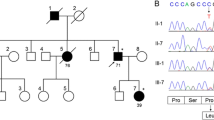Abstract
We describe a family with dominantly inherited ataxia of late adult onset. Expansion of a CAG repeat in the gene encoding the α1A voltage-dependent calcium channel was identified at autopsy in one patient, a 65-year-old woman with a disease duration of 11 years. In this patient, pathological changes were confined to the cerebellar cortex and inferior olivary complex. The cerebellar cortex showed severe loss of Purkinje cells with proliferation of Bergmann’s glia, being more pronounced in the superior parts of the vermis and hemispheres. In the inferior olivary complex, a reduced neuronal cell population, which could be interpreted as a change secondary to the cerebellar cortical lesion, was evident. We conclude that the pathological phenotype of this newly classified autosomal dominant cerebellar ataxia, SCA6, is cerebello-olivary atrophy, or more strictly cerebellar cortical atrophy.
Similar content being viewed by others
Author information
Authors and Affiliations
Additional information
Received: 27 May 1997 / Revised, accepted: 27 October 1997
Rights and permissions
About this article
Cite this article
Takahashi, H., Ikeuchi, T., Honma, Y. et al. Autosomal dominant cerebellar ataxia (SCA6): clinical, genetic and neuropathological study in a family. Acta Neuropathol 95, 333–337 (1998). https://doi.org/10.1007/s004010050807
Issue Date:
DOI: https://doi.org/10.1007/s004010050807




